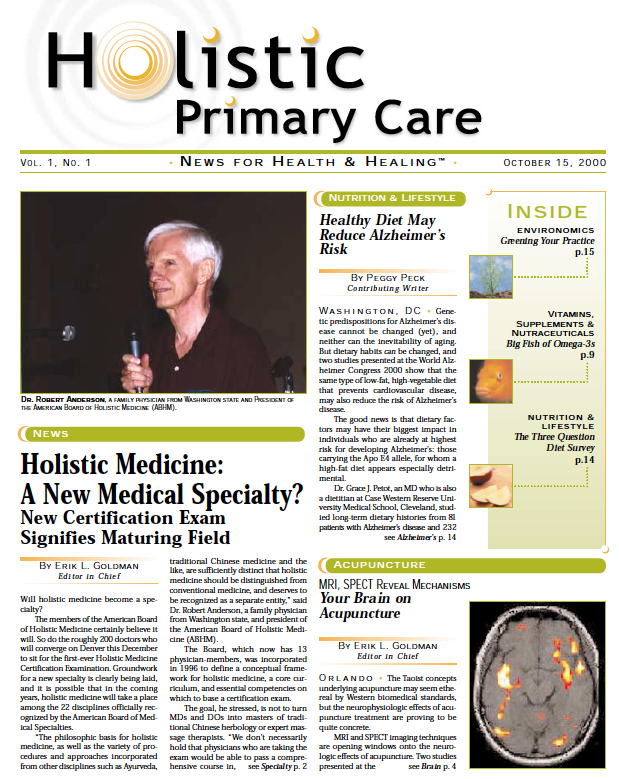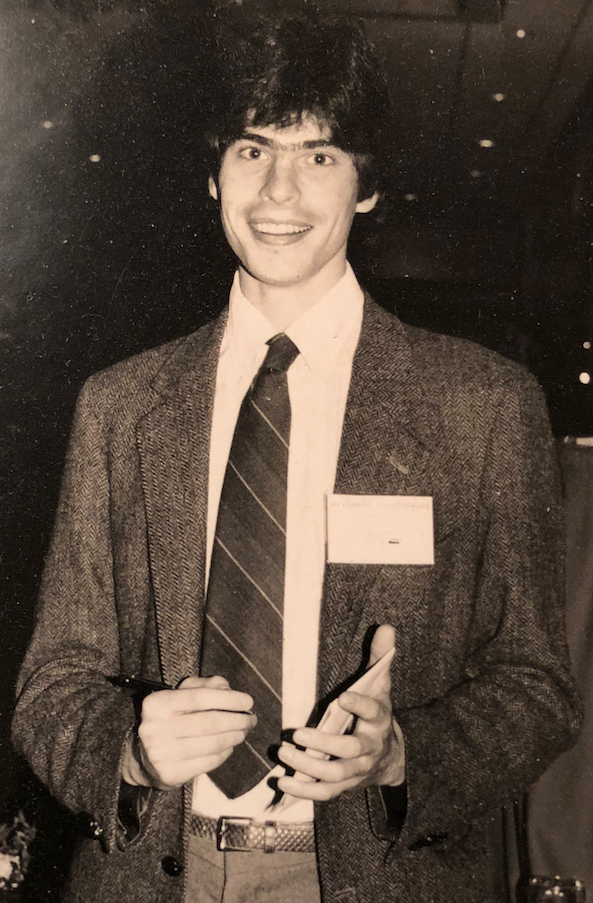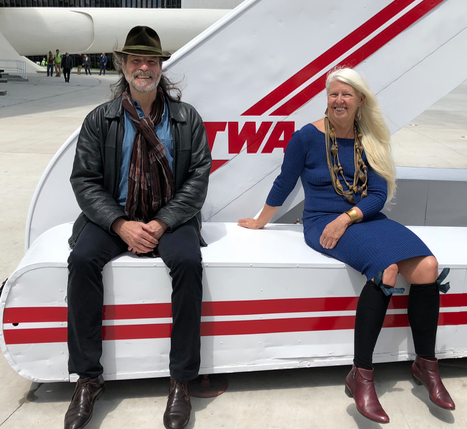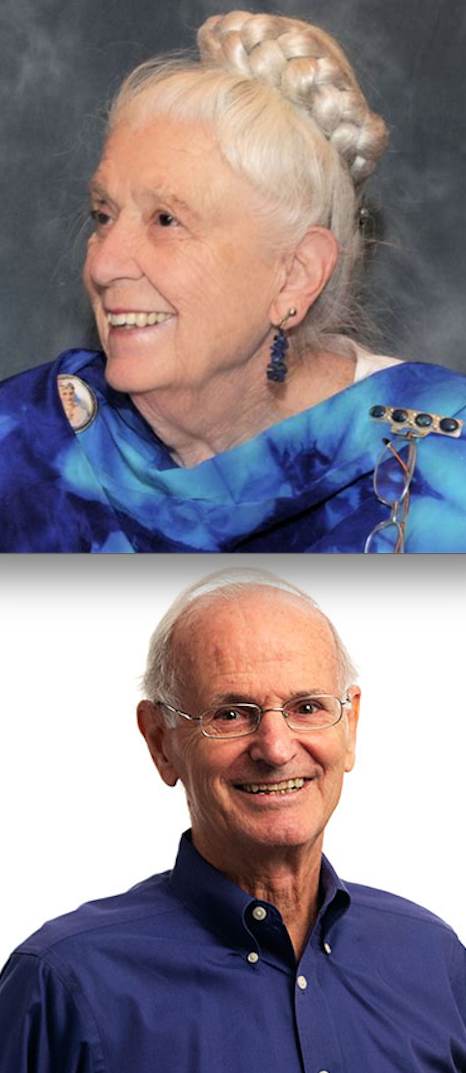 This year marks Holistic Primary Care’s 20th birthday. As we take stock of our journey so far, I want to thank all of you who’ve been loyal readers of and contributors to this publication over the years. If you’re new to HPC, welcome to our community.
This year marks Holistic Primary Care’s 20th birthday. As we take stock of our journey so far, I want to thank all of you who’ve been loyal readers of and contributors to this publication over the years. If you’re new to HPC, welcome to our community.
Meg Sinclair and I launched HPC in 2000, with a simple vision: to provide primary care physicians and other healthcare professionals with inspiring and scientifically-sound information about natural, non-pharma options for preventing and treating common chronic conditions.
The seed for HPC was planted in 1985, when I was a novice medical journalist, fresh out of college, and covering conventional medical specialties for pharma-sponsored publications.
In reporting on CME conferences, I quickly noticed that almost all the presentations were on drugs, high-tech diagnostics, and invasive surgeries. There was almost nothing on nutrition or prevention, beyond lip service about “dietary and lifestyle change,” and rote messages on sunscreens, mammograms, and digital rectal exams.
Yet we already knew, back then, that the major risk factors for chronic conditions are rooted in lifestyle and environment. I was aware of the vibrant research emerging from the margins of mainstream medicine on subjects like acupuncture, hypnosis, herbal medicine, antioxidant vitamins, Ayurveda, and other “alternative” approaches. I was equally aware that millions of Americans—myself and most of my friends included—were engaging with “alternative” medicine in some way.
 “Why is nobody paying attention to this? Someone ought to create a magazine about holistic medicine for doctors,” I thought to myself, never for a moment thinking that this “someone” was me. What did I know about starting a business?
“Why is nobody paying attention to this? Someone ought to create a magazine about holistic medicine for doctors,” I thought to myself, never for a moment thinking that this “someone” was me. What did I know about starting a business?
Enter Meg, HPC’s instigator-in-chief, without whom none of this would have happened. She took on the daunting role of publisher, and provided the practical executive skills and financial support needed to translate the vision of HPC into reality. Together we undertook a mission with a very long arc: to help practitioners put the “health” back in healthcare.
Much has changed in medicine—especially holistic medicine––since October 2000, when the first edition of HPC reached thousands of practitioners nationwide:
We’ve seen the emergence of holistic and functional medicine clinics at many of the nation’s top medical centers, among them Mayo Clinic, Cleveland Clinic and Duke University.
We’ve witnessed a blossoming and maturing of scientific research on nutrition, dietary change, herbal medicine, and the clinical application of nutraceuticals.
We’ve watched the evolution of the natural products industry, the emergence of new collaborative practice models, and the rise of powerful healthcare IT that combine to empower individuals to take charge of their health and wellbeing.
We’ve chronicled the mainstreaming of concepts and practices––everything from omega-3 fatty acids and probiotics to yoga and meditation—that were once taboo in conventional care settings.
I am old enough to remember when mainstream internists and gastroenterologists categorically dismissed gluten sensitivity, intestinal permeability, and food allergies as “psychosomatic” or imaginary. Today, institutions like Mayo issue guidelines for improving their diagnosis. That’s all to the good.
Yet despite the progress, much remains frustratingly the same as it was 20 years ago.
Too many mainstream institutions still treat holistic and functional medicine like a novelty or a marketing ploy.
The economic framework of insurance-based medicine still incentivizes prescriptions and procedures. Despite all the marketing tropes about “patient centered care” and “wellness,” insurers still provide little incentive for the practice of truly preventive, holistic care.
As a result, many practitioners struggle to keep their practices afloat financially, and too many people cannot access the care they want and need. Insurance-free models seem to work to support holistic practice, but membership costs put them out of reach for the vast majority of Americans.
Too many of the field’s pioneering institutions—University of Arizona’s Center for Integrative Medicine and Beth Israel’s Continuum Center are but two examples—were shuttered owing to lack of support from parent hospital systems, or failure to develop sustainable fiscal models.
In both the public and private sectors, research spending on drugs for late-stage disease is still vastly greater than that for the study of nutrition, herbal medicine, or self-care practices. Yet life-saving “blockbuster” drugs are fewer and farther between.
And while millions of Americans struggle to pay for their healthcare—and some resort to crowd-funding campaigns to cover medical expenses—the CEOs of major insurance plans, continue to pay themselves tens of millions each year.
 Meanwhile, our elected officials continue to play political football with the issue of whether or not health insurance is a right, a privilege, or a burden, while largely ignoring the factors that stoke illness and the interventions that would improve health status.
Meanwhile, our elected officials continue to play political football with the issue of whether or not health insurance is a right, a privilege, or a burden, while largely ignoring the factors that stoke illness and the interventions that would improve health status.
There’s no question, the field of holistic medicine has grown over the last two decades. But it appears to be stuck at the tipping point, so to speak.
We know millions of people want this kind of medicine, and thousands of practitioners wish to offer it. Yet the insurers have created a seemingly impassable and long-standing bottleneck.
The field faces new challenges, too. As we describe in this edition, Google has made major changes in its search algorithms aimed at limiting public exposure to information about “speculative and/or experimental medical treatments.” Depending on how those terms are defined, that could cover a broad swath of holistic, functional, and naturopathic medicine.
But who’s defining these terms? To what end? For whose benefit?
At HPC, we feel pride in our “20/20 foresight.” We were among the first medical publications to write about the microbiome and probiotics. We began exploring genomics and personalized medicine back in 2002, long before they became hot trends. We’ve been sounding the alarm about the health impact of environmental degradation since before Greta Thunberg was born!
Through all these changes, and our diverse projects––the production of our seven Heal Thy Practice conferences, our ongoing webinar series, and most recently, our industry-focused Practitioner Channel Forum––our ultimate objective remains the same: to inform and inspire you as practitioners of holistic, functional and naturopathic medicine.
One of the great rewards of this work has been the opportunity to meet, interview, and often become friends with brilliant, innovative physicians and researchers—people who have lit the way and cleared the path toward a more humane approach to medical care.
have lit the way and cleared the path toward a more humane approach to medical care.
On April 23, we will be celebrating HPC’s 20th Anniversary and honoring two of those pioneers––Dr. Gladys Taylor McGarey and Dr. Bill Manahan—with a gala event at the spectacular TWA Hotel at JFK Airport in NYC.
Still strong and vital at 99, Dr. McGarey is truly the mother of holistic medicine. She earned her MD at a time when there were so few female med students that she had to sleep on an x-ray table for want of a proper dorm room. Dr. McGarey maintained a practice of holistic family medicine in Scottsdale, AZ, for more than 60 years, and was among the first American physicians to use acupuncture.
She is also among the first MDs to introduce spirituality, dream interpretation, and lifestyle coaching into medical practice. A co-founder of the American Holistic Medical Association (now the Academy of Integrative Health & Medicine) in 1977, she continues her work through her own Foundation for Living Medicine.
Dr. Bill Manahan has been at the forefront of the movement to bring nutrition, exercise, mind-body disciplines, and spirituality into conventional medical schools and clinics. He is professor emeritus of Family Medicine & Community Health at the University of Minnesota Medical School, and a faculty member at UMN’s Center for Spirituality and Healing. He also served on the clinical faculty at the Mayo Medical School for 20 years.
In 1982, he founded the Wellness Center of Minnesota in 1982, one of the first physician-led integrative medicine centers in the nation. In 1994, he co-founded Open Door Health Center in Mankato, MN, which continues to provide care for more than 5,000 underserved and uninsured individuals each year. Dr. Manahan is a past-president of the American Holistic Medical Association, and currently serves as a facilitator for International Integrators, a global non-profit organization bringing nutrition-based integrative medicine to communities worldwide.
At our 20th Anniversary Gala, on Thursday April 23, we will honor the achievements of Dr. McGarey, Dr. Manahan, and other visionaries, celebrate our two decades of progress, and set our sights on a healthier, more humane, and sustainable future.
If you’re in the New York metro area, or you’re looking for a great reason to enjoy a bit of Springtime in NYC, we hope you’ll join us at the spectacular TWA Hotel at JFK Airport to celebrate our brainchild’s 20th birthday! Purchase your seats here.
END







